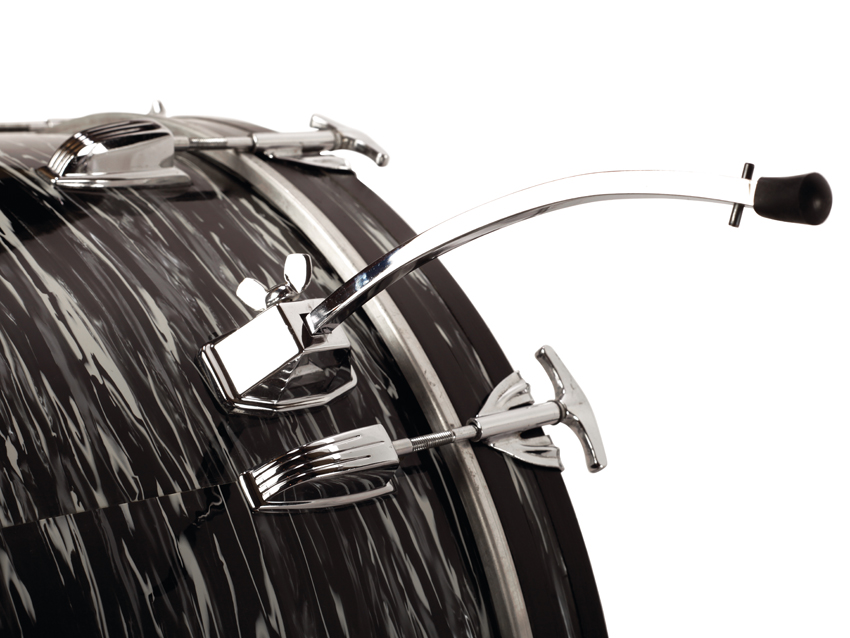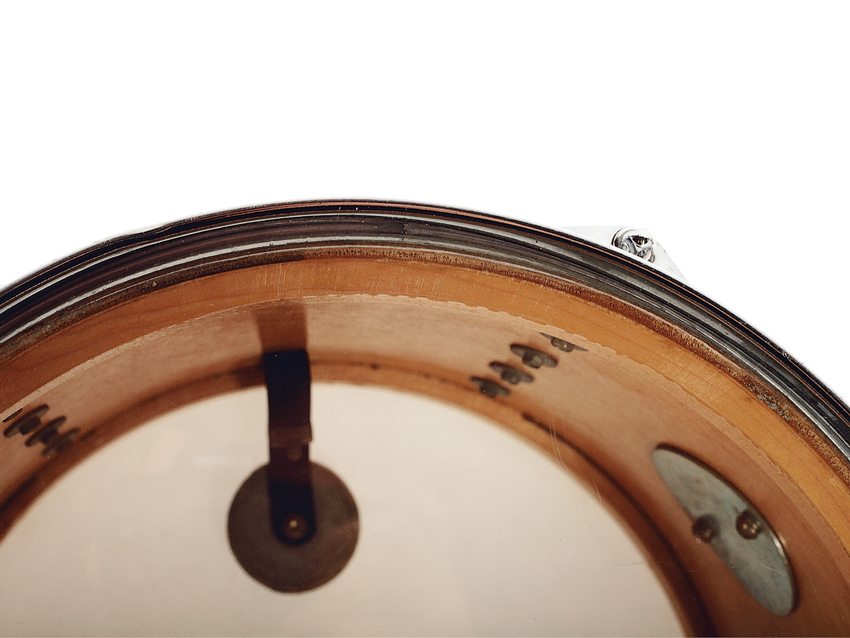Vintage Drum Gear: Ludwig kits
A '60s showman's kit and a '70s Buddy Rich set-up

Ludwig Blue Note kit
Each month Rhythm Magazine tracks-down and checks-out vintage gear in order to marvel at a bit of drum-making history. Here we have two classic kits from Ludwig...
Last year’s UK National Drum Fair threw up a broader-than-ever selection of vintage kits, none more magnificent than this complete Ludwig Blue Note.
Essex drummer and ex-fireman Steve Roots is the proud owner and he says, “The Blue Note was first seen in the 1959 Ludwig catalogue and made its last appearance in 1971.
“Mine came via eBay from a dealer in Denver, USA, in October 2003. I bid £1600 and got it. The serial numbers on all the keystone badges are close and all the shells are dated inside, July 1969.”

Ludwig Blue Note kit
We photographed Steve’s Blue Note as it appears in the catalogue shots, complete with bongos, cowbells and canister throne.
There are two 22x14-inch bass drums, 12x8-inch, 13x9-inch, 16x16-inch and 18x16-inch toms. Earlier Blue Notes had paired 12x8-inches, but by 1967 one had been replaced by a 13x9-inch.
The Blue Note also included a matching wood shell Jazz Festival snare right up till the final 1971 catalogue shot, which has a metal-shelled SupraPhonic 400. The original snare is the only piece missing from Steve’s kit and he’s provided a 400 for the pictures. It’s likely many late-’60s drummers would in any case have requested a 400 snare.
There are two other fascinating things about Steve’s kit. Look closely you’ll see the 18-inch tom and canister throne have the earlier, Ringo-style Oyster Black Pearl wrap, while the rest of the kit has a transitional, slightly lighter-patterned Oyster Black.
Soon after this Ludwig went to a noticeably different Oyster Black, usually called ‘bowling ball’. Inside the shells, the reason becomes clear. The 18-inch and canister have clear mahogany shells which would probably have been made in the late-’50s.
The rest of the drums have maple shells. However, they are all dated July 1969, which indicates when the kit was put together in the factory. It would seem Ludwig had these two items hanging around for years (they probably sold very few 18-inch toms and canisters) and conveniently made up the Blue Note with them in 1969.

Ludwig Blue Note kit
Completing the authentic Blue Note spec are the paired bongos on their stand, two Speed Kings, hi-hat, two bass drum cymbal mounts, double tom mount and separate cymbal stand.
Steve says, “The cymbal stands came with crown toppers, but I went back to the original felts and leather washers. There were white paint flecks over the kit so I used T-Cut to get rid of those and I restored the chipped bass drum hoops using a satin black car spray.
“It had certainly had some use. But I didn’t have to touch the chrome or replace any nut boxes, etc. I don’t use it for gigging. I was asked to do a ’60s night and I just didn’t have the bottle to take it out!”

Ludwig White Marine Pearl kit
Following that late-’60s Ludwig, here’s another desirable Luddy from a few years later.
At the end of the ’60s Ludwig was riding high, ‘The Most Famous Name On Drums’, when the company made a couple of significant changes. Out went the classic gold keystone badge to be replaced by a big bold and modern blue-and-olive badge. And the shells changed from African mahogany, painted white on the inside, to American maple, with clear sealed interiors.
Our kit belongs to Derbyshire drummer Graham Pratt. Graham originally bought it as a three-piece Super Classic without a snare.
He says, “I’ve had it just over 10 years. I used to be in a big soul band in Manchester and I used a Sonorlite kit. But I wanted a Super Classic and a mate who buys and sells came along with it, so I grabbed it. The kit came from the UK. I have all the Hercules stands that go with it and a proper Ludwig stool with ‘Ludwig’ stamped in the seat.”

Ludwig White Marine Pearl kit
So Graham originally bought a Super Classic, 22x14-inch, 13x9-inch and 16x16-inch. He later added a second 16x16-inch floor tom and a Jazz Festival snare drum.
“I thought it would be nice to have a matching snare and I got this one from the States. A mate bought it while I was on holiday. He left a message saying if you don’t want it I’ll have it. As soon as I saw it I bought it.
“It was in pristine condition, together with its case and I only paid about £300. It has a maple shell like the other drums and the same finish. The serial number though is six-digit, which indicates a bit earlier.”
In fact the serial number suggests 1969 while the original Super Classic has all 1976 serial numbers. The added floor tom has no serial number, which indicates 1972. No matter, since the whole kit matches perfectly.

Ludwig White Marine Pearl kit
With the two floor toms and the single tom way off to the left, the kit is now a Buddy Rich set-up.
Graham says, “The tom mount is original, but someone had put it right in the middle of the bass drum which looked odd and it wouldn’t position low enough. So I put it back to where it should have been, in the Buddy Rich style. If you look carefully you can see the two extra holes that I filled.
“I haven’t used the kit for a while because we moved from Manchester to Chinley in the High Peaks, Derbyshire. I want to get back into playing again though because I love it.
“We used to play all over Manchester, the Trafford Centre, functions with a big brass section. The kit has that soul sound I like and looks perfect for an old soul band.”
Vintage Gear continues each month in Rhythm Magazine.

Geoff Nicholls is a musician, journalist, author and lecturer based in London. He co-wrote, co-presented and played drums on both series of ‘Rockschool’ for BBC2 in the 1980s. Before that he was a member of original bands signed by Decca, RCA, EMI and more. ‘Rockschool’ led to a parallel career writing articles for many publications, from the Guardian to Mojo, but most notably Rhythm magazine, for which he was the longest serving and most diverse contributor.